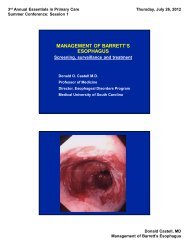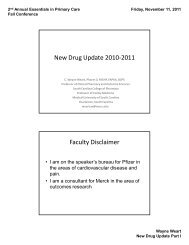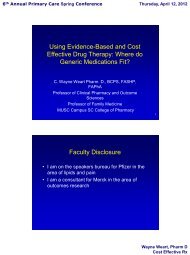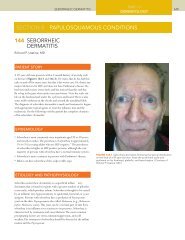Chronic Pain and Drug Seeking Patients - CME Conferences
Chronic Pain and Drug Seeking Patients - CME Conferences
Chronic Pain and Drug Seeking Patients - CME Conferences
You also want an ePaper? Increase the reach of your titles
YUMPU automatically turns print PDFs into web optimized ePapers that Google loves.
3 rd Annual Essentials in Primary Care<br />
Summer Conference: Session 1<br />
Tuesday, July 24, 2012<br />
“There’s no pain that’s so easy to bear than<br />
that of someone else.”<br />
Leriche<br />
<strong>Chronic</strong> <strong>Pain</strong> <strong>and</strong><br />
<strong>Drug</strong> <strong>Seeking</strong> <strong>Patients</strong><br />
Grace Forde, M.D.<br />
Director of Neurological Services<br />
North American Partners In <strong>Pain</strong> Management<br />
Van Gogh:<br />
“Old Man in Sorrow”<br />
“We all must die. But<br />
if I can save him from<br />
days of torture, that is<br />
what I feel is my great<br />
<strong>and</strong> ever new<br />
privilege. <strong>Pain</strong> is a<br />
more terrible lord of<br />
mankind than even<br />
death himself.”<br />
Albert Schweitzer<br />
Grace Forde, MD<br />
<strong>Chronic</strong> <strong>Pain</strong> & the <strong>Drug</strong> <strong>Seeking</strong> Patient
3 rd Annual Essentials in Primary Care<br />
Summer Conference: Session 1<br />
Tuesday, July 24, 2012<br />
Opioid Therapy<br />
Opioid therapy have a recognized role in pain<br />
management . For chronic pain, opioids are often<br />
effective when prescribed <strong>and</strong> used appropriately as<br />
part of a structured pain management plan.<br />
One 2010 report indicated that nearly 105 of patients<br />
admitted for substance abuse treatment in 2008<br />
reported prescription pain reliever abuse – an<br />
increase from 2% among admissions in 1998<br />
Opioid Therapy (cont)<br />
The 2008 National survey on drug use <strong>and</strong> health<br />
reported that among Americans aged > 12 years, the<br />
prevalence of nonmedical use of prescriptions ( i.e.<br />
pain relievers, tranquilizers, stimulants, sedatives)<br />
was second only to marijuana use among types of<br />
illicit drud use<br />
There was also a parallel increase in hospitalization<br />
for poisoning by prescription opioids<br />
Grace Forde, MD<br />
<strong>Chronic</strong> <strong>Pain</strong> & the <strong>Drug</strong> <strong>Seeking</strong> Patient
3 rd Annual Essentials in Primary Care<br />
Summer Conference: Session 1<br />
Tuesday, July 24, 2012<br />
Opioid Therapy (cont)<br />
Non adherence to treatment includes taking too much<br />
of the prescribed medication, diverting medication to<br />
other individuals, self medicating with un prescribed<br />
or illicit drugs or taking medication inconsistently<br />
Urine toxicology is one very important way to monitor<br />
opioid adherence<br />
Another way is through REMS<br />
Risk Evaluation <strong>and</strong> Mitigation<br />
Strategy (REMS)<br />
Two main goals<br />
• Mitigate the risk of accidental overdose,<br />
misuse <strong>and</strong> abuse<br />
• Inform patients of the potential serious risk<br />
of addiction with the use of opioids<br />
Grace Forde, MD<br />
<strong>Chronic</strong> <strong>Pain</strong> & the <strong>Drug</strong> <strong>Seeking</strong> Patient
3 rd Annual Essentials in Primary Care<br />
Summer Conference: Session 1<br />
Tuesday, July 24, 2012<br />
Assessment Challenges<br />
<strong>Pain</strong> is subjective 1,2 No satisfactory objective measures 1,2<br />
<strong>Pain</strong> is<br />
multidimensional<br />
Gold st<strong>and</strong>ard for pain assessment<br />
– Patient’s self-report 2<br />
Clinician must consider multiple aspects<br />
of the pain experience<br />
– Sensory, affective, cognitive 3,4<br />
1. APS. Principles of Analgesic Use in the Treatment of Acute <strong>Pain</strong> <strong>and</strong> Cancer <strong>Pain</strong>. 5th ed. Glenview, Ill: American <strong>Pain</strong> Society;<br />
2003. 2. McCaffery M, Pasero C, eds. <strong>Pain</strong>: Clinical Manual. 2nd ed. St. Louis, Mo: Mosby, Inc; 1999:36-102. 3. NPC/JCAHO.<br />
<strong>Pain</strong>: Current Underst<strong>and</strong>ing of Assessment, Management, <strong>and</strong> Treatments. December 2001. 4. Galer BS et al. Clin J <strong>Pain</strong>.<br />
2002;18:297-301. 5. Ramelet A-S et al. Aust Crit Care. 2004;17:33-45. 6. Craig KD et al. Clin Perinatol. 2002;29:445-457.<br />
7. Davis MP, Srivastava M. <strong>Drug</strong>s Aging. 2003;20:23-57.<br />
Clinical Assessment:<br />
Psychosocial History<br />
Current psychiatric symptoms<br />
History of addictive disease<br />
Medical Records <strong>and</strong> Speak to previous<br />
treating physician<br />
Change in social function<br />
– work<br />
– family <strong>and</strong> relationships<br />
– recreation<br />
Medical-legal status<br />
Grace Forde, MD<br />
<strong>Chronic</strong> <strong>Pain</strong> & the <strong>Drug</strong> <strong>Seeking</strong> Patient
3 rd Annual Essentials in Primary Care<br />
Summer Conference: Session 1<br />
Tuesday, July 24, 2012<br />
Trial of Opioid Therapy<br />
Document realistic goals<br />
Patient education<br />
Treatment agreement <strong>and</strong> informed consent<br />
forms<br />
Begin with short-acting agents<br />
Titrate to optimal effect<br />
Aggressively manage side effects<br />
Document exit strategies<br />
Creating an Exit Strategy<br />
Upon initiating opioid therapy, agree with<br />
patient on criteria for failure of the trial<br />
Common failure criteria include:<br />
– lack of significant pain reduction<br />
– lack of improvement in function<br />
– persistent side effects<br />
– persistent noncompliance<br />
Document method for tapering off opioids<br />
if trial is not successful<br />
Grace Forde, MD<br />
<strong>Chronic</strong> <strong>Pain</strong> & the <strong>Drug</strong> <strong>Seeking</strong> Patient
3 rd Annual Essentials in Primary Care<br />
Summer Conference: Session 1<br />
Tuesday, July 24, 2012<br />
Patient Care Agreement/<br />
Informed Consent Components<br />
Reminder: opioids are one modality in multifaceted<br />
approach to achieving goals of therapy<br />
Detailed outline of procedures <strong>and</strong> expectations<br />
between patient <strong>and</strong> doctor<br />
Prohibited behaviors <strong>and</strong> grounds for tapering or<br />
discontinuation<br />
Limitations on prescriptions<br />
Refill <strong>and</strong> dose-adjustment procedures<br />
Exit strategy<br />
Patient Care Agreement / Informed<br />
Consent Components (cont)<br />
They will not use Illegal drugs ( including Marijuana)<br />
They will not change their dose without prior discussion<br />
with the provider<br />
They will not obtain scheduled substances from another<br />
provider without notifying the pain physician (including<br />
the ER doc)<br />
They will get their prescription filled at a single pharmacy (<br />
of their choosing)<br />
They will obtain consultations or go to PT if asked to<br />
They will NOT be given early refills if the medications are<br />
used up early, lost or stolen<br />
They agree to r<strong>and</strong>om urine drug screening<br />
Grace Forde, MD<br />
<strong>Chronic</strong> <strong>Pain</strong> & the <strong>Drug</strong> <strong>Seeking</strong> Patient
3 rd Annual Essentials in Primary Care<br />
Summer Conference: Session 1<br />
Tuesday, July 24, 2012<br />
Opioid Dependence, Tolerance,<br />
Pseudoaddiction, <strong>and</strong> Addiction<br />
What are the differences<br />
Physical dependence: Withdrawal syndrome would occur if the<br />
medication is discontinued abruptly, dose is reduced rapidly, or an<br />
antagonist is administered 1,2<br />
Tolerance: A greater amount of medication is needed to maintain<br />
therapeutic effect, or loss of effect over time 2<br />
Pseudoaddiction: Behavior suggestive of addiction caused by<br />
undertreatment of pain 2 ; can be a major barrier to appropriate<br />
treatment of patients in pain<br />
Addiction (psychologic dependence): A biopsychosocial disorder<br />
characterized by continued compulsive use of a substance despite<br />
harm 2,3<br />
1. APS. Guideline for the Management of Cancer <strong>Pain</strong> in Adults <strong>and</strong> Children. Glenview, Ill: American <strong>Pain</strong> Society; 2005.<br />
2. Savage SR et al. APS Consensus Statement. Glenview, Ill: American <strong>Pain</strong> Society; 2001. 3. Fishbain DA et al. Clin J <strong>Pain</strong>.<br />
1992;8:77-85.<br />
Patient Reassessment Model<br />
The "Four A's of <strong>Pain</strong>"<br />
Analgesia<br />
Activities of daily living<br />
Adverse effects<br />
Aberrant drug-taking behaviors<br />
Important to remember two other “A’s”<br />
Assessment<br />
Action (treatment plan)<br />
Grace Forde, MD<br />
<strong>Chronic</strong> <strong>Pain</strong> & the <strong>Drug</strong> <strong>Seeking</strong> Patient
3 rd Annual Essentials in Primary Care<br />
Summer Conference: Session 1<br />
Tuesday, July 24, 2012<br />
Assessing <strong>Patients</strong> at Risk for<br />
Opioid Addiction: Screening for<br />
Substance-Abuse Potential<br />
Predictive of Aberrant Behavior Use Caution With<br />
Alcohol consumption<br />
<strong>Drug</strong> use<br />
Men who drink >4 alcoholic beverages<br />
per day or >16 per week<br />
Women who drink >3 alcoholic<br />
beverages per day or >12 per week<br />
Persons who admit to recreational<br />
use of marijuana or hashish in the<br />
previous year<br />
History of addictive disease<br />
Smoking<br />
Persons who are
3 rd Annual Essentials in Primary Care<br />
Summer Conference: Session 1<br />
Tuesday, July 24, 2012<br />
Urine <strong>Drug</strong> Screen<br />
The current recommendation<br />
is to do a urine drug screen<br />
initially before any opioid is<br />
prescribed <strong>and</strong> then<br />
subsequently on a r<strong>and</strong>om<br />
basis<br />
Urine Toxicology<br />
Detection time of most drugs in urine is 1-3 days; longer<br />
if drug is lipophilic<br />
Types of urine drug test<br />
– immunoassays <strong>and</strong> gas chromatography/mass<br />
spectrometry<br />
– high-performance liquid chromatography<br />
Before ordering a test, ascertain<br />
– if patient is taking any prescribed, OTC, or herbal drugs<br />
– when the last dose/quantity was<br />
– drug abuse/addiction history<br />
Make sure laboratory knows what you are looking for<br />
<strong>and</strong> how to look for it<br />
Grace Forde, MD<br />
<strong>Chronic</strong> <strong>Pain</strong> & the <strong>Drug</strong> <strong>Seeking</strong> Patient
3 rd Annual Essentials in Primary Care<br />
Summer Conference: Session 1<br />
Tuesday, July 24, 2012<br />
Predictive Variable for an Abnormal<br />
Urine <strong>Drug</strong> Screen<br />
Younger age<br />
Type of medication <strong>and</strong> dose<br />
were poor predictors<br />
Urine Toxicology<br />
St<strong>and</strong>ard urine screening tests only report whether<br />
various classes of drugs are present or absent based<br />
on an arbitrary cut off level. Therefore need to ask<br />
when the last dose was taken <strong>and</strong> how much.<br />
The st<strong>and</strong>ard immunoassay reacts only with natural<br />
opiates (such as morphine, codeine, hydrocodone<br />
<strong>and</strong> hydromorphone<br />
Semi –synthetic <strong>and</strong> synthetic opioids (such as<br />
fentanyl, oxycodone <strong>and</strong> oxymorphone) are likely to<br />
be missed. Although very high doses of<br />
semisynthetic opioids such as oxycodone maybe<br />
picked up<br />
Grace Forde, MD<br />
<strong>Chronic</strong> <strong>Pain</strong> & the <strong>Drug</strong> <strong>Seeking</strong> Patient
3 rd Annual Essentials in Primary Care<br />
Summer Conference: Session 1<br />
Tuesday, July 24, 2012<br />
Urine Toxology (cont)<br />
To identify specific drugs <strong>and</strong> their CONCENTRATION<br />
in the urine, gas chromatography / mass spectometry<br />
(GC/MS) or high performance liquid chromatography<br />
(HPLC) is used. Therefore, unexpected positive <strong>and</strong><br />
negative immunoassay results should be confirmed<br />
by one of these more specific techniques.<br />
Urine <strong>Drug</strong> Screen (Cont)<br />
Codeine is metabolized to morphine, but not vice<br />
versa<br />
Hydrocodone is metabolized to hydromorphone, but<br />
not vice versa<br />
Oxycodone is metabolized to oxymorphone, but not<br />
vice versa<br />
In addition some patients treated chronically treated<br />
with morphine can have relatively small quantities of<br />
hydromorphone in their urine as a result of a minor<br />
pathway<br />
Grace Forde, MD<br />
<strong>Chronic</strong> <strong>Pain</strong> & the <strong>Drug</strong> <strong>Seeking</strong> Patient
3 rd Annual Essentials in Primary Care<br />
Summer Conference: Session 1<br />
Tuesday, July 24, 2012<br />
Cannabinoids<br />
Recent studies have shown that Cannabinoids<br />
alleviate Multiple Sclerosis related pain <strong>and</strong> other<br />
Neuropathic pain states, <strong>and</strong> have an opioid spearing<br />
effect in pain relief.<br />
In Canada <strong>and</strong> the UK, a plant derived Cannabinoid<br />
nasal spray ( Sativex) is approved for pain <strong>and</strong><br />
spasticityof MS.<br />
However, since marijuana cannot be purchased<br />
legally in the US, we cannot knowingly prescribe<br />
opioids to anyone who is using marijuana<br />
Methadone<br />
Methadone pose a unique problem, since the urine<br />
drug concentration can vary by hydration <strong>and</strong> urine<br />
output<br />
There is some evidence that measuring creatinine<br />
levels <strong>and</strong> the metabolite of methadone 2-ethylidene-<br />
1,5-dimethyl 1-3,3-diphenylpyrrolidine (EDDP) can<br />
give more accurate results.<br />
Currently no quantitative screening method is<br />
available that accurately identifies dosage regiment<br />
through over or under use<br />
Grace Forde, MD<br />
<strong>Chronic</strong> <strong>Pain</strong> & the <strong>Drug</strong> <strong>Seeking</strong> Patient
3 rd Annual Essentials in Primary Care<br />
Summer Conference: Session 1<br />
Tuesday, July 24, 2012<br />
Treatment Guidelines for Opioid<br />
dependence fro the american Society<br />
of addiction medicine (ASAM)<br />
Consider acute intoxication <strong>and</strong> / or withdrawal<br />
potential<br />
Biomedical conditions <strong>and</strong> complications<br />
Emotional , behavioral, or cognitive conditions <strong>and</strong><br />
complications<br />
Readiness to change<br />
Relapse, continued use, or continued problem<br />
potential<br />
Recovery / living environment<br />
The American Psychiatric<br />
Association Guidelines<br />
The APA identified the following three treatment<br />
modalities to be effective strategies for managing<br />
opioid dependence <strong>and</strong> withdrawal<br />
• 1<br />
• 2<br />
• 3<br />
Opioid substitution with Methadone or buprenorphine,<br />
followed by a gradual taper<br />
Abrupt opioid discontinuation with the use of clonidine to<br />
supress withdrawal symptoms<br />
Clonidine-Naltrexone detoxification<br />
Grace Forde, MD<br />
<strong>Chronic</strong> <strong>Pain</strong> & the <strong>Drug</strong> <strong>Seeking</strong> Patient
3 rd Annual Essentials in Primary Care<br />
Summer Conference: Session 1<br />
Tuesday, July 24, 2012<br />
Medications used in the treatment of<br />
Opioid Addiction<br />
Buprenorphine ( Buprenex, Subutex)<br />
• Can be used for moderate to severe pain <strong>and</strong> / or opioid<br />
dependence<br />
Buprenorphine / Naloxone (Suboxone)<br />
Naltrexone ( ReVia, Vivitrol, Depade)<br />
• Indicated for the prevention of relapse to opioid dependence<br />
following opioid detoxification<br />
• Also indicated for the treatment of alcohol dependence<br />
Naloxone (Narcan)<br />
Clonodine (Catapres)<br />
Grace Forde, MD<br />
<strong>Chronic</strong> <strong>Pain</strong> & the <strong>Drug</strong> <strong>Seeking</strong> Patient
3 rd Annual Essentials in Primary Care<br />
Summer Conference: Session 1<br />
Tuesday, July 24, 2012<br />
Treatment of the patient with chronic<br />
pain <strong>and</strong> a history of Addiction<br />
Reassure patient that their addiction history will not<br />
prevent adequate pain management<br />
Verify Methadone or buprenorphine dose with the<br />
clinic or prescribing M.D.<br />
Aggressively treat pain with conventional opioids.<br />
Opioid cross tolerance often necessitates higher<br />
doses at shorter intervals<br />
Use adjuvant medications liberally<br />
Use long acting opioids instead of PRNs, except for<br />
patients on methadone<br />
For patients on buprenorphine therapy refer to an<br />
addiction specialist<br />
Medico-legal<br />
Considerations<br />
Grace Forde, MD<br />
<strong>Chronic</strong> <strong>Pain</strong> & the <strong>Drug</strong> <strong>Seeking</strong> Patient
3 rd Annual Essentials in Primary Care<br />
Summer Conference: Session 1<br />
Tuesday, July 24, 2012<br />
Regulatory Issues<br />
Risk of regulatory censure low if<br />
procedures are followed <strong>and</strong> documented<br />
Relevant regulations include:<br />
– federal (DEA)<br />
– state policies<br />
Useful model guideline from Federation of<br />
State Medical Boards. Available at:<br />
www.fsmb.org<br />
Grace Forde, MD<br />
<strong>Chronic</strong> <strong>Pain</strong> & the <strong>Drug</strong> <strong>Seeking</strong> Patient









